Recent Articles
Popular Makes
Body Types
2020 Dodge Durango Road Test and Review
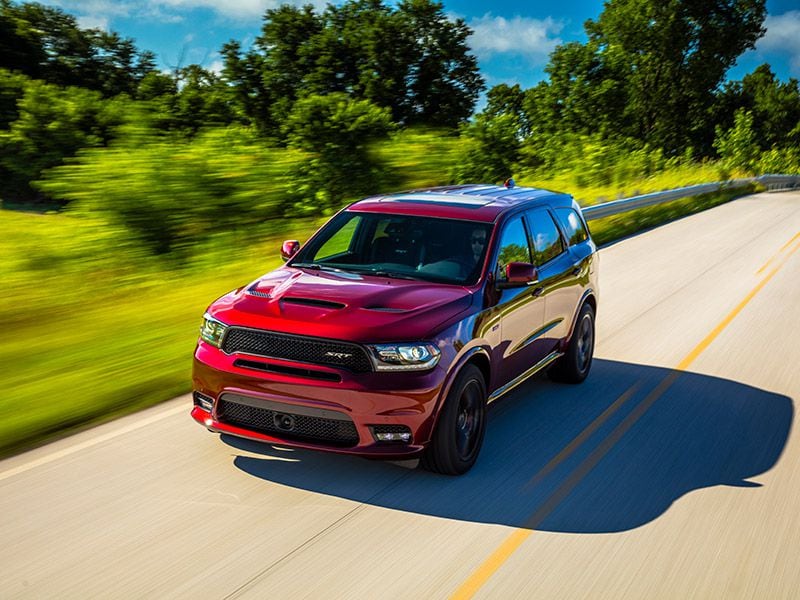
2020 Dodge Durango SRT hero ・ Photo by Fiat Chrysler Automobiles
The 2020 Dodge Durango is a conventional sport utility vehicle doing battle against a rising tide of crossover SUVs. The Durango hangs its hat on its rear-wheel drive platform, something the Ford Explorer has just returned to, and among its powertrains, it features the burly Hemi V8, an engine unlike anything available from the crossover set.
The Durango is a three-row SUV that combines advanced technology with traditional features like serious towing ability and lengthy range per tank. Its classic good looks are complemented by an upscale interior that can be equipped like a luxury sedan. If you’re looking for performance, the Durango SRT is the fastest and most powerful three-row SUV from an American brand, with 475 horsepower on tap. But even with the base V6 Pentastar engine, the Durango is well-equipped to tote your family and all your stuff.
Contemporary Exterior Design
The Dodge Durango is a sleek, contemporary SUV that gets more sinister-looking in its SRT and GT versions. It wears many faces, but in several of them, its most distinguishing characteristic is the Dodge signature “crosshairs” grille. The crosshairs grille has a substantial chrome surround, but in the SRT and GT the crosshairs vanish, the grille is blacked-out and its “surround” is body-colored.
The Dodge stylists haven’t bowed to the inclination to slope the vehicle’s rear end and give it excessive tumblehome. Because of that, the Durango offers more interior room and utility. The tailgate is attractive, if not especially distinctive. In R/T, SRT, and GT forms, the Durango is festooned with scoops and an optional hood appliqué that give it a more menacing look, prompting FCA to say it is like a three-row Dodge Charger.
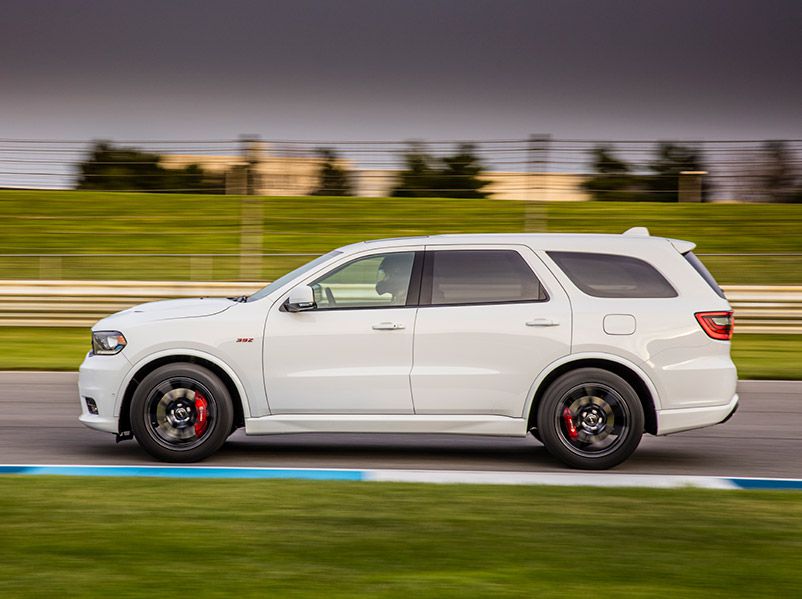
Photo by Fiat Chrysler Automobiles
Handsome Interior
The various Dodge Durango models offer a staggering amount of versatility. In all, the seats in the Durango can be configured in 50 different ways. The base SXT has standard five-passenger seating, while seven-passenger seating and second-row captain’s chairs are available on the GT and R/T. Durango Citadel and SRT models feature standard second-row captain’s chairs and six-passenger seating. The available captain’s chairs in the second row offer a pass-through to the two-person third row, and each can accommodate a child safety seat. Those seeking more people-carrying ability can opt for the 60/40 split-folding second-row seat that conveniently folds and tumbles out of the way.
The interior is well-designed and well-finished. In the SRT version, it has the look of an upscale import crossover with leather-covered bucket seats. The instruments are legible and easy to understand, and we like the convenience of the controls gathered in the dashboard's center stack.
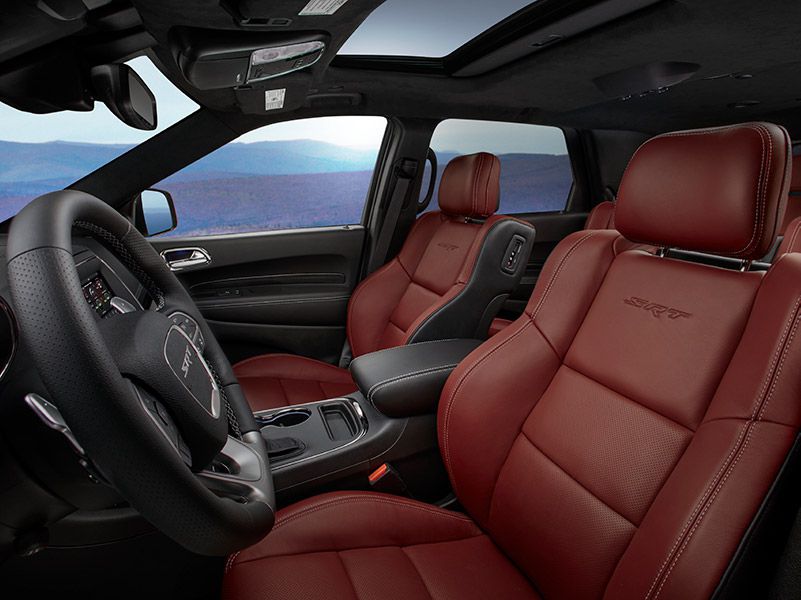
Photo by Fiat Chrysler Automobiles
Infotainment
The 2020 Durango offers a variety of the latest easy-to-use Uconnect systems, among our favorites. The choice of 7- or 8.4-inch touchscreen displays features the functionality of Apple CarPlay and Android Auto. We appreciated the seamless way Apple CarPlay integrates an iPhone with the car’s built-in display and controls. Using the familiar system drivers can make phone calls, access music, send, and receive messages and receive voice-guided navigation optimized for traffic conditions. Android Auto delivers similar well-integrated features for users of Android phones.
While this is the era of streaming video, the Durango offers a class-exclusive Blu-ray video rear entertainment system. It has two high-resolution 9-inch screens, one on each front seatback. Each screen allows passengers to watch content on Blu-ray or standard DVDs or play their gaming systems via inputs for HDMI or RCA cables. Wireless headphones and a wireless remote are included.
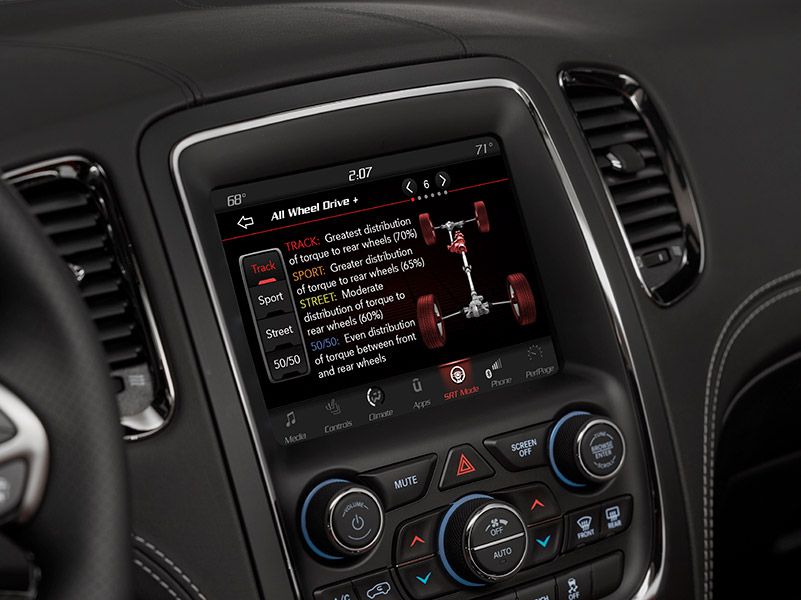
Photo by Fiat Chrysler Automobiles
Powertrains
The Durango’s most powerful engine is the 6.4-liter (392-cubic-inch) Hemi V8 standard in the high-performance SRT. It delivers 475 horsepower and 470 lb-ft of torque. So equipped, the SRT will vault from zero to 60 mph in just 4.4 seconds. And for you drag racers in the crowd, it will pass through the quarter-mile in an NHRA-certified 12.9-seconds.
But that isn’t the only Hemi V8 available in the Durango. The R/T and Citadel-level trims can be equipped with the 5.7-liter Hemi that produces 360 horsepower and 390 lb-ft of torque. It is equipped with cylinder deactivation technology that shifts between four-cylinder and eight-cylinder mode depending upon the vehicle’s power requirements. The Durango’s standard 3.6-liter Pentastar V6 engine produces 293 horsepower (295 horsepower on Blacktop Package) and 260 lb-ft of torque. Models with the V6 offer engine stop-start that lowers emissions while also saving fuel. Several sophisticated all-wheel-drive systems are offered.
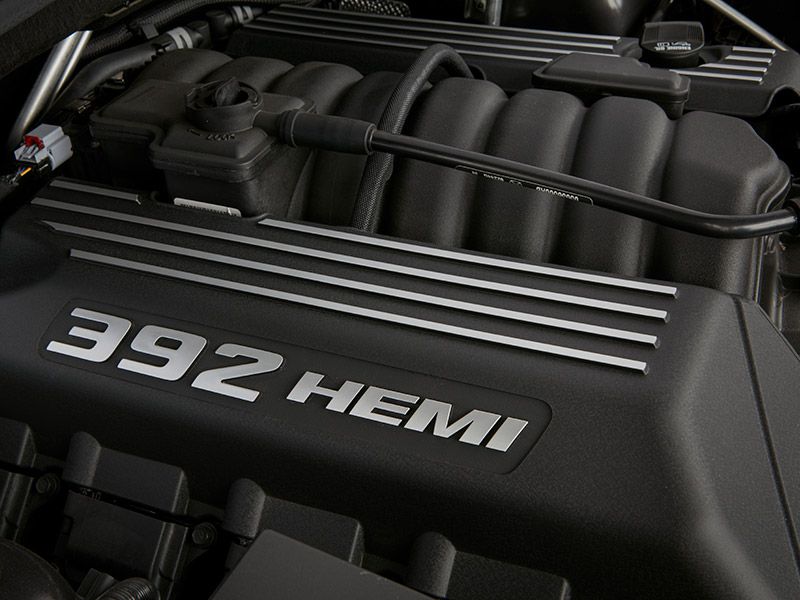
Photo by Fiat Chrysler Automobiles
Driving Impressions
The Dodge Durango SRT is a tall race car; there’s no other way to describe it. If you want to wring performance — and serious towing capability — out of your three-row SUV, it is one heck of a bargain. It’s not just straight-line fast either. The FCA engineers have given good all-around handling abilities.
Those of you who don’t care to race your SUVs will likely find a good compromise in the V8-equipped R/T and Citadel versions. The R/T is more performance-oriented, while the Citadel is a powerful, luxurious SUV in the classic tradition. If we were picking an SUV for a long family road trip, the Citadel would likely be our choice. At the same time, we like the overall feel and relative economy of the trims equipped with the Pentastar V6. The standard eight-speed automatic transmission offers imperceptible shifts and can be operated in manual mode with available steering-wheel-mounted paddle shifters.
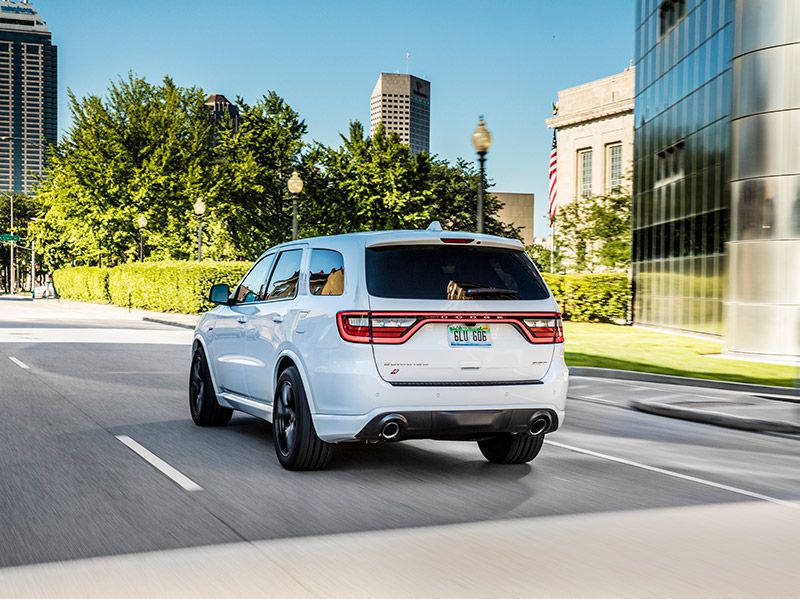
Photo by Dodge
Safety and Driver Aids
The Dodge Durango can be equipped with an impressive array of more than 60 safety and security features. Each Durango is fitted with seven airbags, including full-length three-row side-curtain airbags, front-seat-mounted side-thorax airbags, front-row active head restraints, and trailer-sway control.
Standard across the range, electronic stability control includes a vehicle stability management system, electronic roll mitigation, all-speed traction control, brake assist, and four-channel anti-lock brakes. Standard hill-start assist prevents the Durango from rolling back for two seconds when you start the vehicle on an incline. Additional extra-cost safety features include a forward collision warning with crash mitigation, adaptive cruise control with stopping capabilities, blind-spot monitoring, and rear cross-path detection. Also available is Uconnect Access with 911 calling and roadside assistance features.
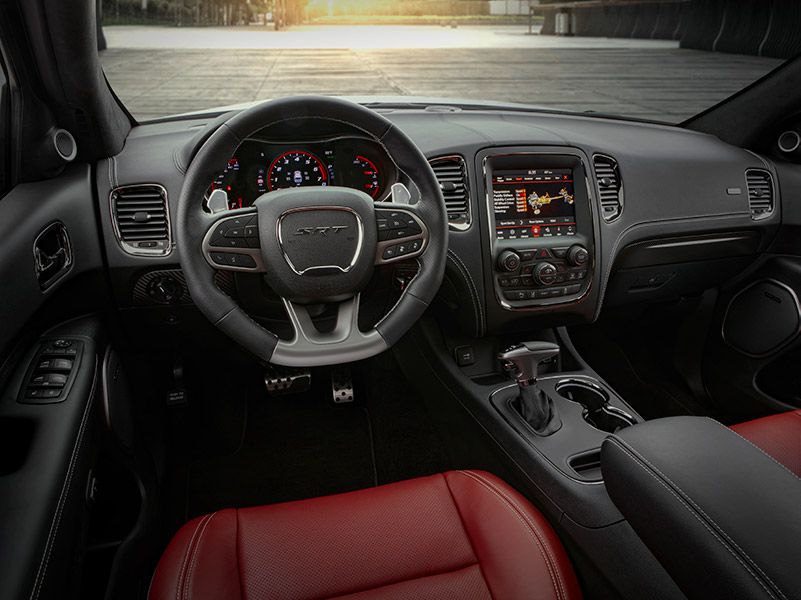
Photo by Fiat Chrysler Automobiles
Towing and Fuel Economy
The Durango is a traditional SUV, and that has special benefits when it comes to towing. Equipped with the 293-horsepower 3.6-liter Pentastar V6 engine, the Durango offers maximum towing of 6,200 pounds. That’s a pretty serious load, but the V8-equipped Durangos take it up several notches. When fitted with the 5.7-liter Hemi, the Durango’s tow rating is 7,400 pounds. The SRT sends the rating even higher. With the 392-cubic-inch V8, it delivers a best-in-class towing capability of 8,700 pounds.
The most economical Durango model has EPA ratings of 19 mpg in the city, 26 mpg on the highway, and 21 mpg overall. Both rear- and all-wheel drive Durangos with the 5.7-liter V8 offer ratings of 14 mpg city/22 mpg highway/17 mpg overall. And the 6.4-liter SRT delivers 13 mpg city/19 mpg highway/15 mpg overall.
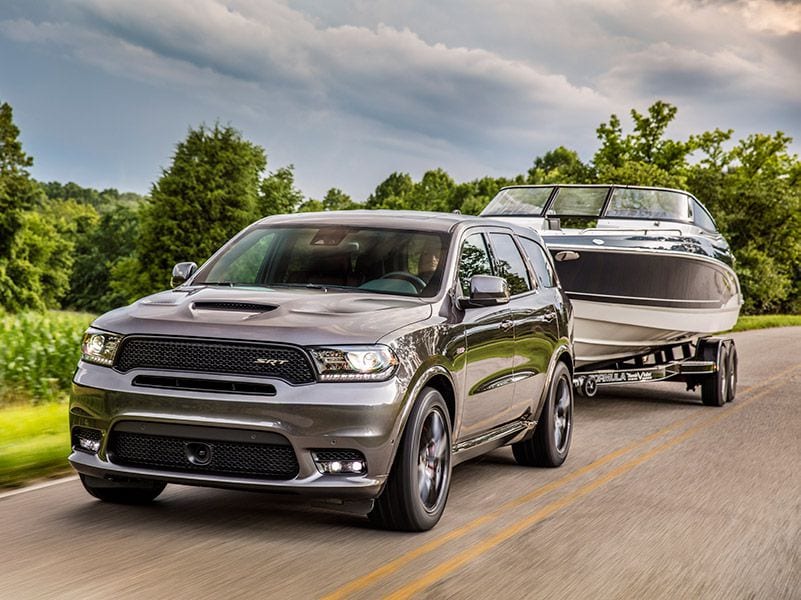
Photo by Dodge
Interior and Cargo Space
The Dodge Durango has offers a combined 141.4 cubic feet of passenger space in three rows of accommodations. With the third-row seat in use, it has 17.2 cubic feet of cargo space. With the third row folded, the Durango has 43.3 cubic feet of cargo area. And with both rows of rear seats folded, it offers an impressive 85.1 cubic feet.
For the 2020 model year, the Durango has a power liftgate operated by the key fob, overhead console, and rear cargo area controls. It is part of the Popular Equipment Group and standard on GT Plus and higher trim levels of the SUV. The Durango doesn’t have the interior space or flexibility of a minivan, but it is right there with the best SUVs in its class.
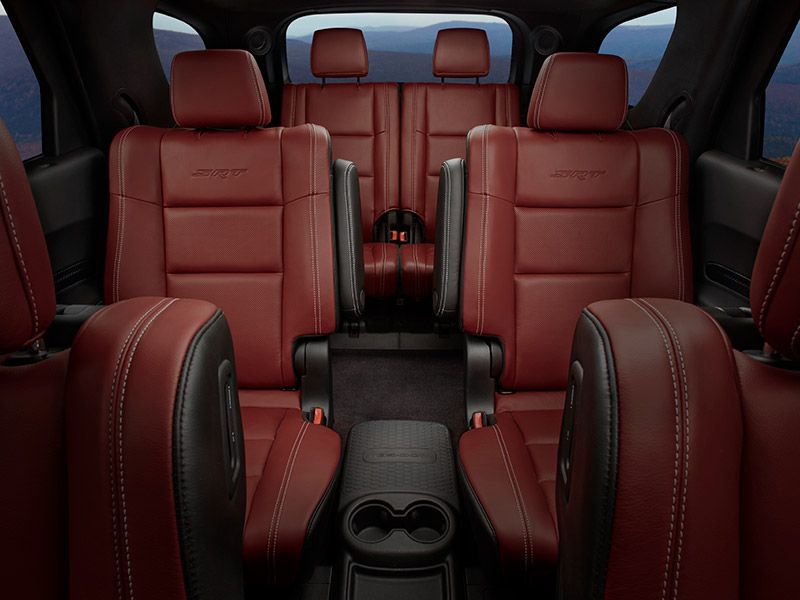
Photo by Fiat Chrysler Automobiles
Trim Levels
The Durango is available in five different trim configurations: SXT, GT, R/T, Citadel, and SRT. Both rear-wheel drive and 4x4 versions are offered in each trim level with the exception of the performance-oriented SRT, which uses all-wheel-drive to get its potent power to the pavement.
The SXT is the value-oriented trim level, equipped with the V6. The GT offers exterior styling similar to the SRT in a V6-powered package, while the R/T does much the same while featuring the impressive 5.7-liter Hemi V8. As mentioned earlier, the Citadel trim is a more luxurious, suburban-oriented version of the vehicle with more chrome brightwork. In addition to its performance orientation, the SRT is also the best-equipped version of the Durangos.
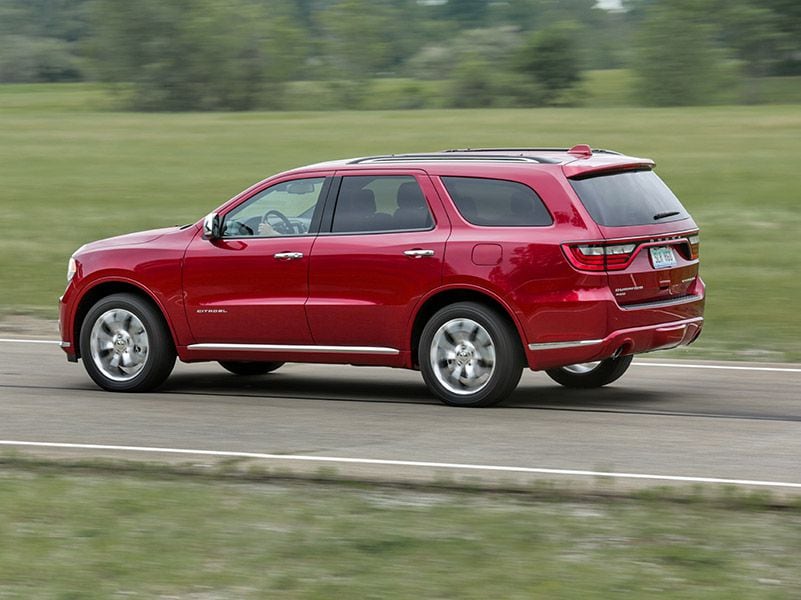
Photo by Fiat Chrysler Automobiles
Pricing and Value
The Dodge Durango offers trim levels at various price points, each with an increased level of equipment and performance. There are lower-cost versions for those who want the looks and aura of the SRT without the expense and fuel economy penalties of the 6.4-liter engine. Much as we like the V8-powered Durangos, we think the SXT and GT versions are likely the best values.
The base rear-wheel drive SXT (a five-seat vehicle) has an MSRP of $30,495. The rear-drive GT is $34,645. Climbing the ladder to the V8-powered R/T with rear-drive takes the price to $43,995. For those looking to bask in a wealth of features, the Citadel trim starts at an MSRP of $45,595. Finally, the high-performance SRT has an MSRP of $62,995. The Durango is built in Detroit, Michigan.
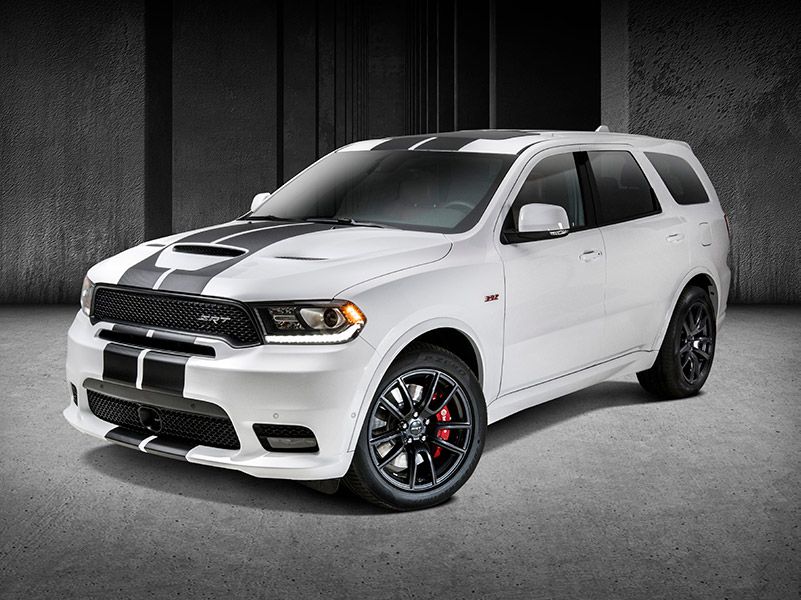
Photo by Fiat Chrysler Automobiles